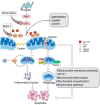Exploring the correlation between Drp1 protein and the neurotoxicity of propofol
- PMID: 40761317
- PMCID: PMC12319030
- DOI: 10.3389/fnins.2025.1614362
Exploring the correlation between Drp1 protein and the neurotoxicity of propofol
Abstract
Neurotoxicity is a common toxic reaction associated with the use of the anesthetic drug propofol. With the widespread use of propofol, the issue of neurotoxicity has garnered significant attention. Mitochondria are the energy metabolism centers of cells and play a crucial role in biological processes such as cell growth and development, invasion and metastasis, division and differentiation, and apoptosis. Dynamin-related protein 1 (Drp1) is a key regulator of mitochondrial fission that can modulate the dynamic balance of mitochondria and plays an important role in maintaining mitochondrial morphology and function. The abnormal expression of Drp1 is closely related to the occurrence and development of various pathological conditions. Through a systematic review of multi-species animal and cellular studies, we elucidated the correlation between Drp1 and propofol-induced neurotoxicity. By analyzing Drp1-mediated mitochondrial fragmentation across different organ systems, this work provides crucial theoretical foundations for developing Drp1-targeted strategies in propofol neurotoxicity detection, prevention, and pharmacological intervention.
Keywords: Drp1; mitochondria; neuroprotection; neurotoxicity; propofol.
Copyright © 2025 Guo and Mei.
Conflict of interest statement
The authors declare that the research was conducted in the absence of any commercial or financial relationships that could be construed as a potential conflict of interest.
Figures
References
Publication types
LinkOut - more resources
Full Text Sources
Research Materials
Miscellaneous



